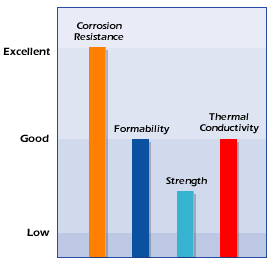304L Stainless Steel Sheet, Coil, and Plate - AMS 5511, 5513
304L stainless steel (AMS 5511), is a variation of stainless steel 304 with a lower-carbon content. Type 304L maximum carbon content is 0.03%. It also has lower mechanical properties than 304.
Type 304L materials can be used in the welded condition as opposed to the annealed condition and still maintain resistance to corrosion and lend themselves to many types of fabrication. This grade resists corrosion and is often used in the food industry. United Performance Metals purchases 304L stainless steel dual certified as 304 and 304L.
304L Inventory Size Ranges
Not finding what you are looking for? Connect with our sourcing group at sourcing@upmet.com
Standard Inventory Specifications
- UNS S30403
- AMS 5511
- AMS 5513
- ASTM A 240
- ASTM A 276
- ASTM A 479
- ASTM A 484
- ASME SA 240
Other industry standards we comply with:
- W.NR 1.4307
- PWA-LCS
- GE Aircraft Engine (GT193)
- GE Aviation S-SPEC-35 AeDMS S-400
- RR SABRe Edition 2
- DFARS Compliant
Common Trade Names
- ATI 304L (™ Allegheny Technologies)
- Type 304L Steel
Common Applications of 304L
- Aerospace structures
- Base plates and fasteners
- Food and beverage industry
- Heat exchangers
- Fasteners like nuts and bolts used in corrosive marine environments
- Textiles and acidic dyes
- Processing equipment where corrosion at welded joints is a concern
- Containers for chemicals or transport
Chemical Composition
| Element | Percent by Weight | |
|---|---|---|
| C | Carbon | 0.030 max |
| Mn | Manganese | 2.00 max |
| P | Phosphorus | 0.045 max |
| S | Sulfur | 0.03 max |
| Si | Silicon | 0.75 max |
| Cr | Chromium | 18.000 - 20.000 |
| Ni | Nickel | 8.000 - 12.000 |
| N | Nitrogen | 0.10 Max |
| Fe | Iron | Balance |
304L Physical Properties
- Density: 0.29 lb/in³ (8.03 g/cm³)
- Modulus of Elasticity in Tension 29 x 106 psi (200 GPa)
| Temperature Range | Mean Coefficient of Thermal Expansion | ||
|---|---|---|---|
| °C | °F | mm/mm/°C | in/in/°F · 10? |
| 20 - 100 | 68 - 212 | 16.6 · 10-6 | 9.2 · 10-6 |
| 20 - 870 | 68 - 1600 | 19.8 · 10-6 | 11 · 10-6 |
| Temperature Range | W/m · K | Btu/(hr/ft²/in/°F) | |
|---|---|---|---|
| °C | °F | ||
| 100 | 212 | 16.3 | 9.4 |
| 500 | 932 | 21.4 | 12.4 |
| °C | °F | J/kg °K | Btu/lb/°F |
|---|---|---|---|
| 0-100 | 32-212 | 500 | 0.12 |
Magnetic Permeability
- H/m Annealed
- 1.02 Max @ 200 H
| °C | °F | Microhm-cm | MIcrohm-in. |
|---|---|---|---|
| 20 | 68 | 72 | 28.3 |
| 100 | 212 | 78 | 30.7 |
| 200 | 392 | 86 | 33.8 |
| 400 | 752 | 100 | 39.4 |
| 600 | 1112 | 111 | 43.7 |
| 800 | 1472 | 121 | 47.6 |
| 900 | 1652 | 126 | 49.6 |
Mechanical Properties and Yield Strength of 304L stainless
| Property | 302,304 | 304L |
|---|---|---|
| 0.2% Offset Yield Strength, psi (MPa) | 42 (290) | 35 (241) |
| Ultimate Tensile Strength, psi (MPa) | 90 (621) | 85 (586) |
| Elongation % in 2 in. (50.8 mm) | 55 | 55 |
| Hardness Rockwell | B82 | B80 |

Additional information about 304L
The most common Austenitic grade is Type 304/304L. All other grades are developed from the 18-8 base by adding alloying elements to provide special corrosion-resistance, improved properties or better weldability. Type 304/304L makes up over 60% of all the stainless steel made in world today.
The wide usage of 304/304L stainless steel in food and beverage and pharmaceutical applications reflects the corrosion resistance qualities of these materials. These industries demand that materials do not release significant quantities of contaminants into the product. They must also be easily cleaned. For example, liquid blending and storage tanks are readily cleaned, providing proper hygiene in food prep as well as food and beverage handling. Commercial dishwashing detergents eliminate 97% of microorganisms adhering to stainless steel surfaces. Flavor and color are kept intact, with no impact from contact with the tank material.
Another innovative use of 304/304L can be found in architectural planning. Sustainable engineering provides for a building's longevity and safety. Design guidance for stainless steel structures incorporates the ability to hold up against the most severe natural disasters and even considers the resilience to withstand what we consider normal weather impact over time. One example of sustainable engineering can be found in the National Archives of Canada in Gatineau, Quebec. This impressive structure was designed to withstand flooding and seismic events. The characteristics of nickel-containing Type 304L used in the structure provide safe-keeping for the country's most precious historical documents.
For a deeper understanding of the difference between 304 and 316, request our white paper on the topic.
*The technical data provided is for information only and not for design purposes. It is not warranted or guaranteed.
